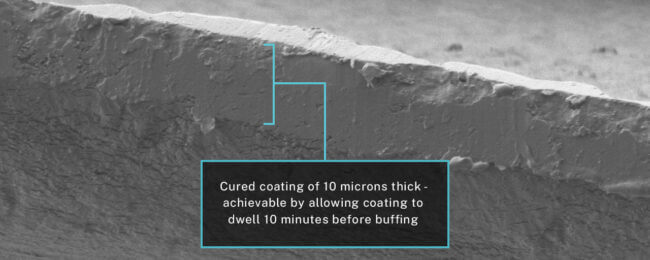FACT OR FICTION: Borophene Coatings
From the guys who pioneered graphene ceramic coatings (yeah, that was us) – we’re diving into the latest so-called ‘nanotech breakthrough’ – BOROPHENE
They say information is power, and we say power to the people! So let’s talk about Borophene coatings. Is this the next big thing in surface protection, or is it just another marketing buzzword dressed up in a lab coat? Buckle up, because we’re about to separate fact from fiction, hopefully giving you the information needed to make an informed buying decision.

What Is Borophene?
Borophene is a single-atom-thick sheet of boron atoms, making it a 2D material similar to graphene. First synthesized in 2015, it’s been praised for being:
✔ Stronger than graphene
✔ Extremely conductive
✔ Lightweight and flexible
Sounds like a dream material, right? In theory, yes. But in practice, not so much.
The problem is that borophene is highly unstable in air. Unlike graphene, which can be chemically modified to improve stability, borophene reacts rapidly with oxygen and moisture, breaking down almost instantly. That means, if you had a borophene coating, it would literally degrade before you even finished applying it.
So, here’s the big question: If borophene is unstable in air, how exactly are some brands selling “borophene coatings” to you?
The Truth: They’re Not Using Borophene At All
Let’s cut through the marketing hype—these so-called “borophene coatings” do not contain borophene. Instead, they contain borosilicate, a completely different material.
Wait… what’s borosilicate?
Borosilicate is a glass-like material made by combining boron and silica (silicon dioxide). It’s commonly found in:
✔ Lab glassware (think Pyrex)
✔ Cookware
✔ Certain ceramics
While borosilicate is chemically resistant and heat-stable, it doesn’t have the nanostructured properties of borophene. It’s not conductive, not particularly flexible, and not revolutionary in coatings. Borophene has some really exciting possibilities, potentially on the horizon, but for the time being these advancements are not yet scientifically possible in our field. Despite this, some companies are slapping “borophene” on the label and calling it a day.
Why This Matters: The Power of Buzzwords
The detailing industry is no stranger to overhyped science, and “borophene coatings” are just the latest example of marketing trumping reality. These companies are using a real scientific term (borophene) to sell a completely different material (borosilicate). There is a big difference between borophene and borosilicate or other boron derivates and we encourage companies exploring marketing strategies and their customers to keep these distinctions in mind.
Final Verdict: Bro Science Meets TikTok Marketing

If true borophene coatings existed for automotive use, we’d be excited. But right now? They don’t.
Innovation is at the core of Artdeshine and we’re always looking for new ways to improve our products, but more important than just offering something new is upholding strong ethical and moral standards in both our products and marketing. We believe in setting realistic, honest expectations, and we encourage our competitors to do the same
So, before you buy into the hype, ask yourself: Are you getting cutting-edge nanotechnology, or just getting taken for a ride?
Stay informed. Stay skeptical. Stay ahead.
Borosilicate vs. CNT Ceramic Coatings: Which One Wins?
| Performance Factor | Boron-Based Coating (Boron Nitride / Borosilicate) | CNT-Based Ceramic Coating | Winner |
|---|---|---|---|
| Hardness / Scratch Resistance | High, but can be brittle (boron nitride is hard but fractures under stress) | High, with better resistance to cracking and micro-fractures | CNT Coating |
| Durability / Crack Resistance | Brittle—prone to micro-cracking under stress | Superior flexibility and impact resistance | CNT Coating |
| Hydrophobicity (Water Repellency) | Moderate—boron compounds are not inherently hydrophobic | Excellent—CNTs improve water beading and hydrophobic performance | CNT Coating |
| Chemical & UV Resistance | Good, but boron silicates can degrade over time in UV exposure | Excellent—CNTs enhance long-term environmental durability | CNT Coating |
| Thermal Resistance | Very High—boron ceramics are used in high-heat applications | Very High—CNTs improve heat resistance and thermal expansion control | Draw |
| Electrical Conductivity | Poor—boron nitride and boron silicates are electrical insulators | Excellent—CNTs are highly conductive, useful for static dissipation | CNT Coating |
CNT Coatings
CNTs are a true nanomaterial that have been studied and successfully integrated into coatings. In the next iteration of this blog series, we’ll be deep diving into graphene and CNT 🙂
When added to ceramic coatings, CNTs provide:
✔ Increased hardness and impact resistance
✔ Better flexibility, reducing micro-cracking
✔ Superior water repellency and chemical resistance
✔ Proven real-world performance, backed by studies
At Artdeshine, we don’t chase trends – we pioneer real innovations in surface protection. From being the first to introduce graphene-infused ceramic coatings to advancing carbon nanotube (CNT) technology, our focus has always been on scientific validation, real-world performance, and ethical marketing. We believe in setting honest expectations, delivering products that professionals can trust, and ensuring our coatings live up to their claims – without the gimmicks.
If you’re a professional detailer who prioritizes top-performing, proven, and scientifically backed coatings check out our introduction kit and shoot us an enquiry (see bottom of page) to get a 100% discount on your sample pack.
📌 This is the first in our “Fact or Fiction” series, where we break down coatings industry claims so you can make informed decisions. Follow along as we separate science from sales tactics.

